Can Brita Filters Remove Bacteria?
Although Brita pitcher is a very popular brand, it is not a water filter pitcher that remove the most contaminants. Certainly, it cannot remove bacteria from drinking water.
This is because the activated carbon filters ( which Brita used) are designed to reduce the contaminants like chlorine and some heavy metals such as cadmium, copper, and zinc and not pathogens like bacteria.

Since city water is already treated with chlorine and chloramine to kill pathogens, bacteria, and viruses might not be a concern. However, if you are using well water, make sure to have it analyzed before filtering it with your Brita water filter pitcher.
Again, Brita filter water cannot filter out bacteria; you should use water free of microbes. Otherwise, consider other options like reverse osmosis or UV light water treatment that kills bacteria in water.
Why Brita Filters Cannot Remove Bacteria?
Brita water filters are one of the best water filter pitchers as they are popular among those who want to improve the taste of their drinking water. Brita standard filters also use coconut-based activated carbon with ion exchange resin to reduce contaminants and improve the taste of water. However, it is important to understand that these filters cannot kill bacteria from the water. This is because Brita’s activated carbon filter and ion exchange resin are only designed to remove chlorine and a few heavy metals but they do not filter out bacteria or other microorganisms in water coming from the breeding ground.
The most effective way to remove bacteria from drinking water is through reverse osmosis or ultraviolet light treatments. Reverse osmosis is a process where pressure forces water through a semi-permeable membrane that rejects the atoms and molecules of water impurities and microorganisms like viruses and bacteria.
With UV light water treatment, the source water passes through a chamber that contains a UV lamp. The UV light then kills any microorganisms in the water, such as bacteria, fungi, protozoa, and viruses.

Health Effects of Harmful Bacteria Commonly Found in Tap Water
Tap water is one of the most common sources of drinking water, however, it may contain contaminants that can have serious health effects. Harmful bacteria commonly found in tap water, such as E.coli and Cryptosporidium, can cause various illnesses and illnesses-related complications.
It is important to understand the risks associated with drinking contaminated tap water so that people can take steps to protect their health.
Escherichia Coli
E. coli is a type of Enterobacteriaceae family bacterium found in sources of untreated or poorly treated surface waters, including many sources used for drinking water supplies throughout the world. When ingested by humans, it can lead to gastrointestinal issues such as fever, vomiting, and other more severe conditions such as kidney failure or even death.
Legionella Pneumophilia
Legionella Pneumophilia, a bacteria commonly found in water sources, is an increasing concern for public health due to the serious health effects it can cause. The bacteria can be found in tap water, and those with weak immune systems are especially at risk of contracting Legionnaires’ disease from contaminated tap water.
When inhaled, Legionella Pneumophilia can infect the lungs causing pneumonia-like symptoms such as fever, chills, and coughing. In extreme cases, it can even lead to death if left untreated. Those with pre-existing conditions such as asthma or COPD, smokers, and people over 50 are particularly susceptible to infection.
It is important for individuals to be aware of the risks associated with Legionella Pneumophilia and take precautions when drinking from potentially contaminated tap water sources.

Salmonella
Salmonella is a bacteria that can cause serious health effects if ingested. Symptoms include diarrhea, fever, stomach cramps, vomiting, and more. Salmonella poisoning can sometimes lead to dehydration or other potentially deadly complications.
It’s important to be aware of the potential dangers of contaminated tap water so you can take necessary precautions to protect your family’s health. Make sure to properly sanitize any food or drink before consuming it, and consider investing in a filtration system if needed. While it may be inconvenient, these steps are essential for avoiding infection from salmonella or other contaminants in your tap water supply.
Vibrio
Another bacteria which has been identified in tap water in various locations around the world is Vibrio. While Vibrio can cause mild to severe symptoms if ingested, it may also lead to more serious conditions. Vibrio bacteria in tap water can threaten anyone who drinks or uses the water for food preparation.
Symptoms associated with ingesting contaminated water include nausea, vomiting, diarrhea, and abdominal pain. In addition, Vibrio can cause infections such as cholera and septicemia that have life-threatening potential.
The elderly, infants and those with weakened immune systems are particularly vulnerable to serious health problems when exposed to this type of bacterial contamination.

How to Test Water for Bacteria?
Testing water for bacteria is an important part of monitoring the safety of drinking water and other water sources like swimming pools and hot tubs. Bacteria can cause serious illnesses if ingested or in contact with the skin. It is important to understand how to test for bacteria in water so that proper steps can be taken to ensure safe and healthy use.
Use an at-home test kit.
An at-home test kit provides a convenient and easy way to detect the presence of harmful bacteria in both tap and well water. Knowing whether or not your water is safe can help you make informed decisions about the safety of the water you are drinking.
At-home testing kits offer reliable results that can detect small amounts of bacteria in fresh and saltwater samples. These kits typically include everything needed to collect a sample, including sterile containers and sampling devices. Kits also provide instructions on collecting samples to obtain accurate results properly.
At-home test kits come with test strips containing chemicals that react when bacteria are exposed. Users then consult the corresponding color chart to check if the water is contaminated with bacteria.
It’s worth mentioning that test strips only indicate the presence or absence of bacteria in your water. They do not tell you the numeric result or count of the bacteria in the sample.
Have your water analyzed by a state-certified laboratory
Testing your water by a state-certified laboratory is the best way to get accurate results. These laboratories are equipped with the right tools, and professionals perform tests.
When you send a sample of your filtered or tap water to be analyzed, these labs use various methods such as membrane filtration tests, multiple tube fermentation tests, or enzyme-substrate testing to detect potential bacterial contaminants.
Once the analysis is done, the laboratory will provide a report on the testing results by mail or email.
What Contaminants Do Brita Filters Remove or Reduce?
Brita water filters are a great choice for homeowners as they last longer. You can find details here on how long does it last. These filters can remove different contaminants depending on the type of filter.
Brita Standard Filters are designed to remove the chlorine taste and odor, cadmium, zinc, and copper from your source water.
Brita Stream filters, on the other hand, aside from chlorine taste and odor, also remove Trichlorobenzene- a type of volatile organic compound (VOC), and small particulates (<50 micrometers in size).
Of these three filters for pitcher use, Brita Elite Filters (Longlast Filters) remove the most contaminants. Its filtration technology can remove asbestos, VOCs, pesticides and herbicides, and smaller particulates (0.5 to 1-micron size)
The effectiveness of each filter varies depending on what type of filter is used; however, they all have the same basic design, including a carbon-based element with a plastic housing containing ion exchange resin beads to trap the contaminants.
Alternative Water Pitchers that can Remove Bacteria
Clearly Filtered Pitcher
The Clearly Filtered Pitcher is an excellent alternative to a traditional filter pitcher. This filter pitcher uses Affinity filtration technology to reduce contaminants from your tap water, giving you great-tasting, healthy water all the time.
Its advanced filtration system can remove up to 99% of heavy metals and over 365 contaminants such as microplastics, VOCs, pesticides, pharmaceutical residues, and even radiological elements. The filter also leaves beneficial minerals like calcium and magnesium intact, so your water is still full of essential nutrients. Additionally, the filter lasts up to 4 months with typical use – making it a cost-effective solution for home drinking water purification.
Conclusion
Brita water filter pitchers do not effectively remove bacteria from water. This is an important consideration for anyone using a Brita filter to purify their drinking water. While the filter can still help reduce sediment and certain contaminants in the water, it is not an effective tool for removing harmful bacteria.
Therefore, if you are looking to drink purified water without ant bacteria, other water filtration systems should be used, such as an RO system or Clearly Filtered Pitcher. You can also use other methods to purify water, such as boiling or ultraviolet light, instead of the Brita filter.

